April 21, 2023
Conectar Queimados: Transit Oriented Revitalization in Rio de Janeiro
By Iuri Moura, ITDP Brazil
Transit-oriented development (TOD) promotes more integrated urban spaces designed to bring people, activities, buildings, and public spaces together, complemented by walking and cycling connections and accessible transit service to the rest of the city. TOD also means ensuring equitable access to citywide opportunities and resources via an efficient combination of transport modes at the lowest financial and environmental costs, and with the highest resilience to potential disasters. Inclusive TOD is the foundation for safer and more sustainable and accessible cities everywhere.
In Rio de Janeiro, Brazil, one neighborhood urban revitalization plan is seeking to leverage the principles of TOD to implement more compact, integrated, and inclusive development efforts. Conectar Queimados is a project led by the Rio de Janeiro State Government and local transport agencies, with support from the Queimados Municipal Government, SuperVia, and the World Bank. The plan envisions a revitalization of the area around the Queimados train station that builds on principles of accessible, sustainable, and compact design — a model that can ultimately influence neighborhoods across the city.
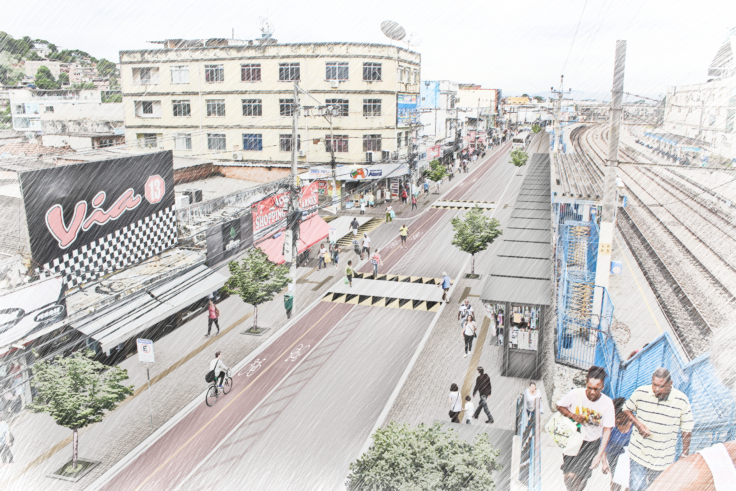
Queimados is located in the Rio de Janeiro metropolitan area and has a population of nearly 150,000 people. It is an important urban center in a region that has significant retail trade, higher education institutions, and an industrial district with the potential to drive economic growth. However, Queimados also faces systemic socioeconomic challenges, including a low human development index and crime. The station — built in the 19th century — has played an essential role in the development of the neighborhood and continues to be a key symbol of local identity. Nevertheless, the station’s relevance has dwindled and the area’s dynamics have changed in recent years — population growth and sprawl have led to more road construction, increased car use, and diminished public services.
The geographic scope of the Conectar Queimados plan is the pedestrian walkshed — the immediate vicinity around the station relative to the average time and distance it takes people to reach it on foot. This specific scope means that all major nearby streets and roads would benefit from interventions that improve local conditions, equity, and access for people using public transport. The proposals developed as part of the plan are based on the multiple stages of diagnostic and feasibility analyses, in addition to the feedback gathered from public engagement activities that sought to highlight local needs.
Considering the conceptual framework used by the World Bank to promote TOD, Conectar Queimados’ proposals emphasize three main values for the revitalization of the area: node value, place value, and market value. Exploring these values is key to understanding the impact that TOD-focused policies can have on the social and economic revitalization of the neighborhood.
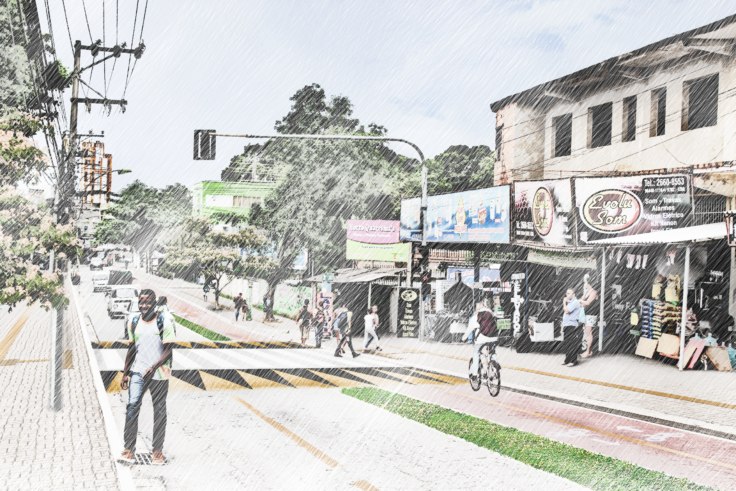
NODE VALUE: IMPROVING PUBLIC TRANSPORTATION
There is decent availability of public transportation in the area covered by the plan, with the presence of a high-capacity train system and numerous municipal and intercity bus lines. Queimados station serves around 30,000 passengers every day under typical conditions. However, accessibility around the station is often precarious, as are the circulation routes and points for boarding and alighting from buses. This situation directly affects the quality of services offered to area residents and discourages people from using trains. To address these challenges, the plan proposes measures that include remodeling the train station; improving the physical integration and emphasis on public transit; and updating guidelines for more accessible fare and operational strategies. Improving the station’s transport connectivity, appeal, and services is fundamental to reshaping peoples’ daily activities in Queimados.
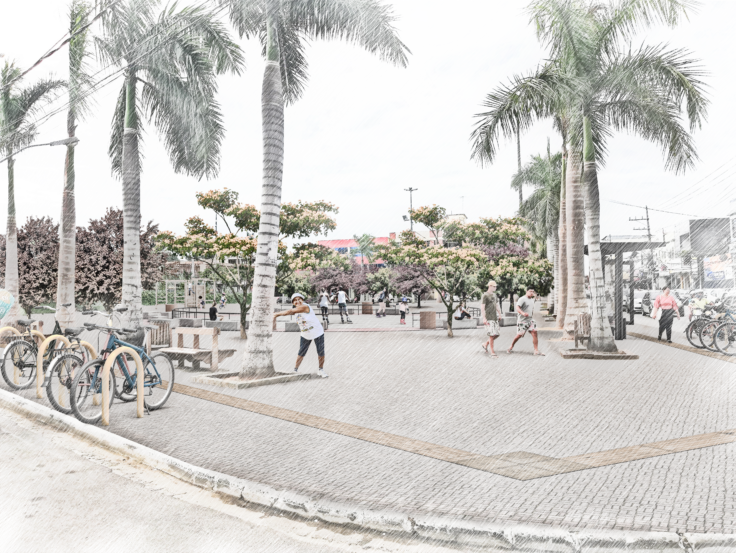
PLACE VALUE: ENHANCING CYCLING, WALKING, AND PUBLIC SPACE
Safe, attractive, and comfortable public spaces are a key component of promoting mobility patterns that are more sustainable, healthier, and less dependent on vehicles. In addition, the quality and livelihood of public spaces are important factors in strengthening local commerce and businesses while encouraging more civic engagement. Strategies that enhance and promote public and open spaces are therefore essential to the area’s revitalization efforts. To address this, the plan includes proposals such as: renovating roads and sidewalks to improve pedestrian access; installing cycling infrastructure with dedicated bicycle parking; renovating high-traffic spaces and plazas; and improving railway crossings for pedestrians and cyclists. As in every city, public spaces that encourage more activity and engagement contribute to better quality-of-life for all residents
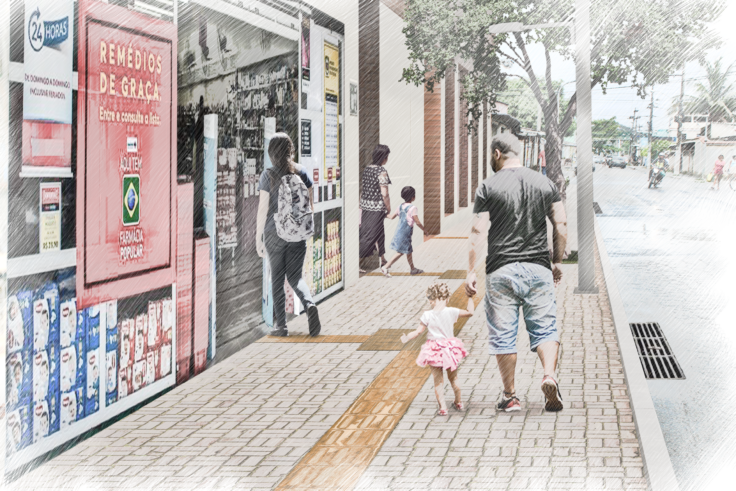
MARKET VALUE: STIMULATING LOCAL ECONOMY AND DEVELOPMENT
The area around the station currently has many undeveloped or underutilized plots of land (estimated at over 18% of the total). Real estate development is timid, despite city regulations that allow for greater building density. The potential for meaningful and inclusive new development is significant. While market value can be a key to stimulating investment and economic growth, it is also important to ensure that new development strategies do not displace existing low-income and minority groups. To address this issue — particularly for populations living in favelas — the Conectar Queimados plan incorporates special proposals for regulation improvements and inclusive zoning measures aimed at protecting the vulnerable populations living in the area. To pave the way for economic development, the plan offers several recommendations. This includes: inducing building density to intensify local business activity; encouraging more mixed-use development; regulating building parking requirements; encouraging sustainable construction practices; and promoting land value capture policies. If strategies for economic and real estate growth take a considered approach, the potential to improve small businesses and increase access to opportunities and services is significant.
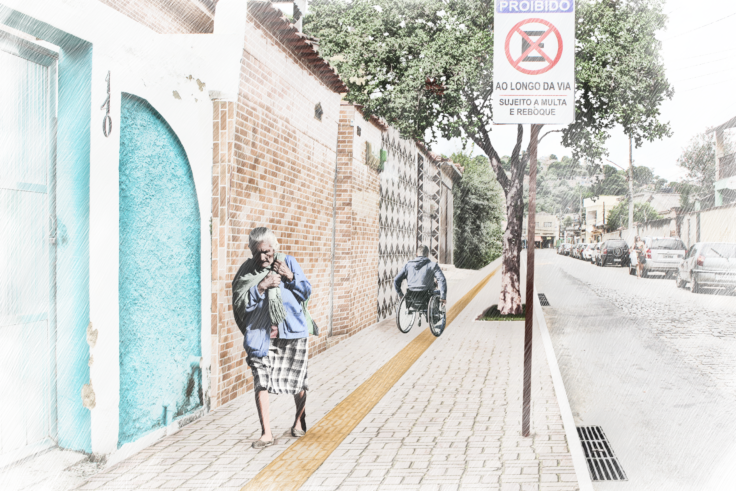
Ultimately, the Conectar Queimados plan presents a first step towards a broader, more integrated citywide planning effort that can better distribute investments and opportunities throughout diverse neighborhoods. The long-term vision is for the plan to be used as a model for shaping similar initiatives across other municipalities, which could help revitalize neighborhoods and communities across the Rio metro area. If Conectar Queimados can be implemented with a strategic focus on inclusion and accessibility for all, the plan can very well serve as a much-needed catalyst for more transit-oriented development across Brazil.
